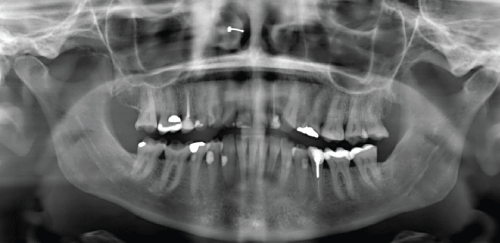
Figure 1: Orthopantomogram.


Polina Kotlarenko1 Tom Vaskovich2 Astrid Skolka3 Andreas Moritz1 Alexandra Kreissl4*
1School of Dentistry, Division of Conservative Dentistry and Periodontology, Medical University of Vienna, Austria*Corresponding author: Alexandra Kreissl, Department of Pediatrics and Adolescent Medicine, Division of Pediatric Pulmology, Allergology and Endocrinology, Medical University of Vienna, Wahringer Street, 18-20, 1090 Vienna, Austria, Tel: +43 (0)1 40400-21481; E-mail: alexandra.kreissl@meduniwien.ac.at
Background: To determine whether a novel restorative digital workflow is feasible for patients with bulimia nervosa.
Methods: This new dental technique was designed and implemented individually for a 32-year-old bulimia nervosa patient, who suffered from the disease over 20 years. The dental treatment was planned virtually by inputting individual parameters from the preliminary diagnostic to develop a novel therapeutic approach, which is a detachable “sample-denture”. The digital workflow was supported by a virtual articulator and a four steps technique. Step 1: only one single impression and bite registration is needed from the first appointment to the restoration. Step 2: determination of a new adequate vertical dimension is supported by a cephalometric analysis and a ‘soft tissue prediction’ technique. Step 3: removable sample dentures support a ‘gradual’ non-invasive introduction to the aesthetic and functional changes. Step 4: non-prep crowns as long-term provisional’s are allowing the fixation of the new full mouth restoration in only one appointment.
Results: A harmonious length-to-width ratio of the front teeth of the upper jaw, improvement of stable lip support, harmonization of the smile-line as well as occlusion contacts, natural tooth anatomy, tooth colour, gummy smile reduction, aesthetic smile, improved articulation and better formation of sounds was achieved. Lateral teleradiograph analysis after verticalization indicated a change of 3.0° for the lower height of the face, intermaxillary relation increased with 1.8°. After treatment chewing difficulties, toothache and tooth sensitivity (hot, cold, sour and sweet) disappeared. The patient stopped vomiting, smoking, and changed eating, physical activity and social behavior.
Conclusions: This is the first dental restorative digital workflow for patients with bulimia nervosa. The minimally invasive technique had impact on dental, lifestyle, nutrition and psychological aspects. A dental restorative digital workflow can help to preserve dental health and to strengthen the compliance of psychotherapeutic treatment with dental psycho-education.
Bulimia nervosa; Psycho-education; Dental erosion; Teeth; Digital dentistry; Full mouth rehabilitation
In the Western industrialized countries, eating disorders represent a serious public health issue among adolescents and young adults [1,2]. Eating disorders like bulimia nervosa are psychosomatic diseases, which are, in turn, associated with severe physical impairments and accompanied with sequelae [3,4]. Recently, particular attention has been focused on long-term effects, which are noticeable only after prolonged persistence of the disease [5,6]. At the beginning, loss of dental enamel on the surface of the teeth usually occurs painlessly [7]. Further progression often leads to large-scale destruction of the upper glaze coat and exposures the underlying dentine [8,9]. Therefore, this might lead to an increased sensitivity to temperature changes and might result in pain caused by sweet or acidic foods consumption [10]. Further, trough-shaped defects in the tooth structure might arise, which can progress so far that the nerve area of the teeth is open and endodontic treatment is needed [8,9]. Bulimia nervosa can cause, besides mental and physical impairments, additional massive tooth decay and damage to the oropharynx [11,7]. Characteristic are especially acid-related tooth loss, also called “erosions” [12]. Current data showed that worldwide 34%, including children and adolescents, have dental erosions [13]. A systematic review and meta-analysis indicated that patients with an eating disorder like bulimia nervosa had five times the odds of dental erosion in comparison to healthy individuals [14].
The action of stomach acid and the misunderstanding in oral hygiene methods, such as strong brushing immediately after vomiting, might eventually lead to these injuries. In most patients with bulimia nervosa, different degrees of erosions severity and lasting consequential damages in function and aesthetics might be detected [15,16].
The dental treatment in the form of restorations will be adjusted as minimally invasively as possible according to the severity of the loss of substance. Between disease onset and diagnosis, often several years elapse, and with longstanding disease processes, massive erosive damage already might be present. In individual cases, a total restructuring plan with restoration of all teeth is necessary to restore aesthetics and in a global loss of occlusal surfaces. Digital dentistry is in dynamic evolution and nearly every day novel opportunities with great significance and new challenges are presented to the dental community. The application of digital transfers from impression taking to the virtual design and CAD/CAM-supported production are seen as a challenge to both dental technicians as well as to dental professionals. It raises several questions concerning indications, limitations and monolithic material selection that are pioneering for the successful implementation of digital technology [17-22].
The current situation and the development of a digital workflow in complex full mouth rehabilitation will be presented on the basis of a special patient case. Thus, we were looking for a novel approach and minimally invasive strategy for the sensitive teeth of patients suffering from bulimia over many years. Therefore, we have designed and determined whether a novel restorative digital workflow is feasible for bulimia nervosa patients.
The novel dental technique was performed at the Bulimia Nervosa Dental Outpatient Clinic, School of Dentistry, and Medical University of Vienna, Austria. The Bulimia Outpatient Clinic offers an interdisciplinary cooperation with psychosocial treatment facilities, a dental point of contact to improve the overall treatment programmed for people with eating disorders.
This restorative work flow represents a retrospective assessment of a novel digital workflow of one bulimia nervosa case report. It does not involve the formulation of a specific research hypothesis, which consequently investigated prospectively into human research. Therefore, we did not seek approval from the ethics committee in consultation with the local ethics committee. However, the patient signed an informed consent form prior to the dental procedure. Moreover, an additional written informed consent form was obtained for the pictures taken from the patient.
A woman with a body weight of 50 kg, suffering from bulimia nervosa for 23 years, was included. At the initial visit of the patient at the Bulimia Outpatient Clinic, detailed dental diagnostics of the current status of the teeth, with special emphasis on the medical history, was performed and documented with pictures. The patient received training about dental consequences of increased acid exposure. Moreover, behavior recommendations for prevention were trained. Free enclosure of appropriate dental care products (e.g. toothpaste, toothbrush, mouth rinse) were given to the patient. Targeted measures were important for remineralization and for teeth protection. The support of a psychotherapist was the requirement for the dental reconstructive treatment.
A 36-year-old female patient came for consultation to the Bulimia Nervosa Dental Outpatient Clinic because of the tooth wear and complained about the short appearance of her teeth (Figures 1-4), which aggravated over recent years.

Figure 1: Orthopantomogram.
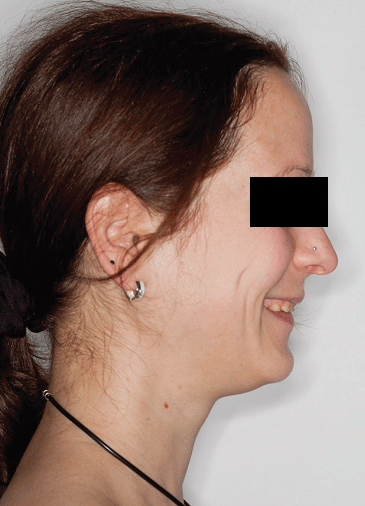
Figure 2: Profile View.
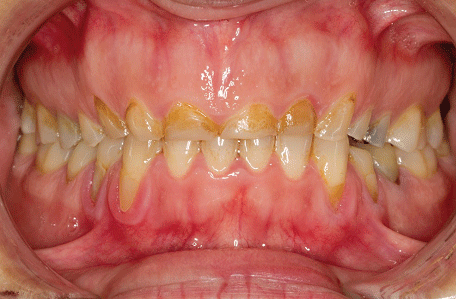
Figure 3: Severe tooth wear due to bulimia.
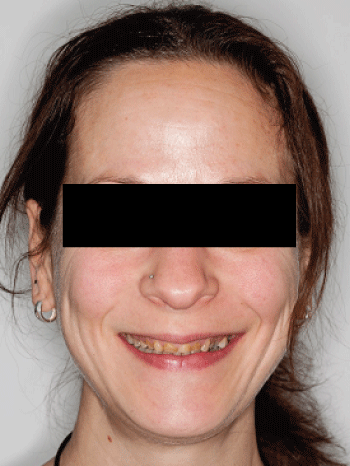
Figure 4: Loss of aesthetic and function.
The teeth were highly sensitive, dental fillings did not hold, problems in sounds formation and articulation, and patient`s psychological stress according to aesthetic loss was noticed. A detailed dental examination as well as radiographs, clinical functional analysis and condylography for the individual programming of the virtual articulator were performed. Periodontal examination showed multiple areas of gingival recession, no probing depths of over 3 mm, no Bleeding on Probing (BOP), and a physiological mobility of all teeth. The sensitivity-test indicated that all teeth responded positively for vitality, with the exemptions of teeth 15, 22 and 35 according to the teeth-terminology of the World Dental Federation (FDI). Radiological diagnostics displayed generalized erosive tooth hardness loss (Figure 1). The smile arc analysis demonstrated a negative smile line, an inverse, upwards convex incisal edge course (Figure 4). Reduction of clinical crown length, a dysharmonic gingival course was clearly visible in the smile (gummy smile) and a non-homogeneous colour of the teeth was observed (Figure 3).
The previous history showed bulimic illness over a period of twenty-three years with vomiting up to ten times per day, seven days per week. The patient was in psychotherapy for 2.5 years and has already reduced the vomiting to twice a day on two days per month [23,24]. According to anthropometric data the body height was 165 cm, body weight was 50 kg and body mass index (BMI) was of 18.4 kg/m². Therefore, the patient was underweight and slightly below the World Health Organization (WHO) cut-off level [25].
The novel therapeutic approach is a detachable “sample-denture”, planned virtually by inputting individual parameters from the preliminary diagnostics. In a generalized loss of occlusal surfaces, usually an invasive restorative approach is needed. An overall treatment plan was conducted with novel restoration of all teeth and change of vertical dimension so that the patient was able to regain adequate aesthetics and function.
The digital workflow was supported by a virtual articulator and a four steps technique.
Step 1-Only one single impression: Only one single impression and bite registration is needed from the first appointment to the restoration, by using the application of the digital transfers from impression taking to the virtual design and computer-aided design (CAD)/computer-aided manufacturing (CAM) supported production (Figure 5).
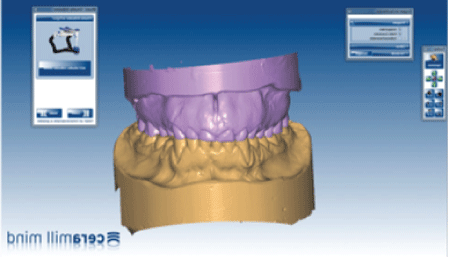
Figure 5: Virtual impression transfer
This single impression technique enables an immense reduction of over-strained appointments, especially for patients with a psychological disorder like bulimia nervosa.
Step 2-Determination of a new adequate vertical dimension: The determination of a new adequate vertical dimension is supported by a cephalometric analysis and a ‘soft tissue prediction’ technique. The cephalometric analysis (Figure 6, Cadias®, Gamma Dental Software) furnished on the one hand the numeric values of the present situation, but allows on the other the virtual preview of changes due to the modifications of lower-facial height [26,27].
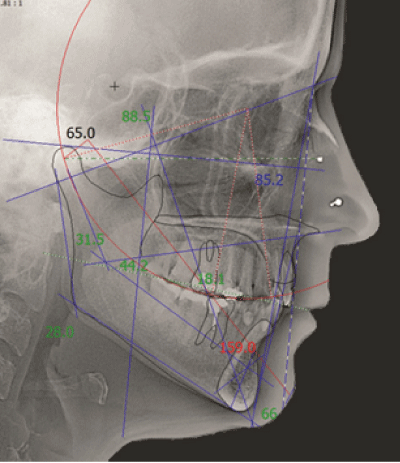
Figure 6: Cephalometric analysis.
In this patient, the raising of vertical dimension to reach an appropriate range could be up to over 10 mm, which needed to be confirmed and adjusted by a soft tissue control, defined by the terminus ‘soft tissue prediction’. This ‘soft tissue prediction’ technique is based upon increasing the vertical dimension through adding splints (ceramill® splintec, Amann Girrbach) in different thicknesses to the full arch to find the correct dental and skeletal position for function and aesthetics (Figures 7,8). The new vertical dimension was assumed at an increase of 10 mm incisal pen.
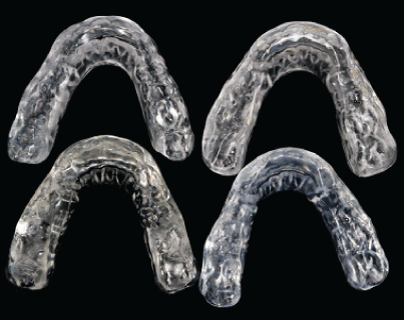
Figure 7: CAD/CAM-manufactured splints.

Figure 8: Intraoral positioned splints for increasing the vertical dimension around five, seven, ten and fifteen millimeter.
Step 3-Removable sample dentures: Removable sample dentures support a ‘gradual’ non-invasive introduction to the aesthetic and functional changes, which are especially helpful in patients with body scheme disorders like bulimia nervosa patients. The CAD/ CAM-manufactured overdentures were milled out of polymethyl methacrylate (PMMA) by a five axis-milling machine (Ceramill Motion, Amann Girrbach) (Figures 9,10). After a settling phase of 3 months, in which the patient was wearing the sample dentures about seven or more hours per day, the patient had time to accept the body changes made by the sample dentures (Figures 11,12).
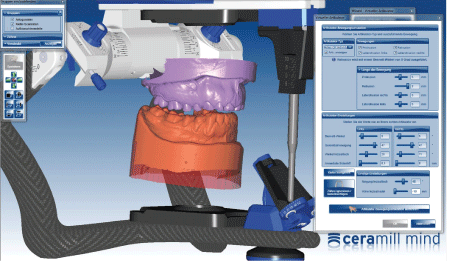
Figure 9: Virtual incensement of the vertical dimension.
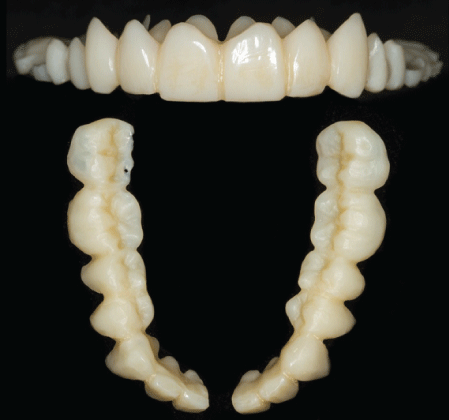
Figure 10: CAD/CAM-manufactured sample dentures.
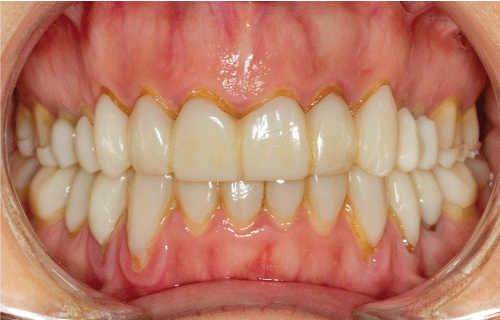
Figure 11: Removable sample dentures in occlusion.
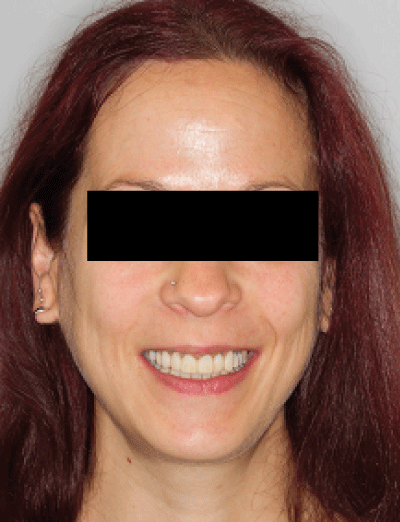
Figure 12: Soft and hard tissue prediction.
Step 4-Non-prep crowns as long-term provisionals: Non-prep crowns as long-term provisionals are allowing the fixation of the new full mouth restoration in only one appointment. In addition, if ever needed, reversal of the restoration is possible. The CAD/CAMmanufactured single crowns were milled out of the hybrid material VITA ENAMIC®, VITA Zahnfabrik and bonded with RelyXTM, 3M ESPE on unprepared teeth (Figures 13-17).
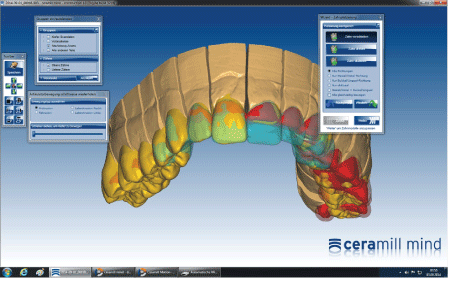
Figure 13: Virtual modification and CAD.
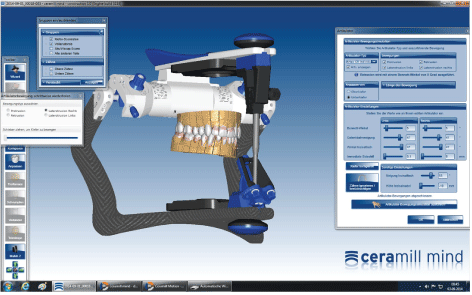
Figure 14: CAM-manufactured Vita Enamic® crowns.
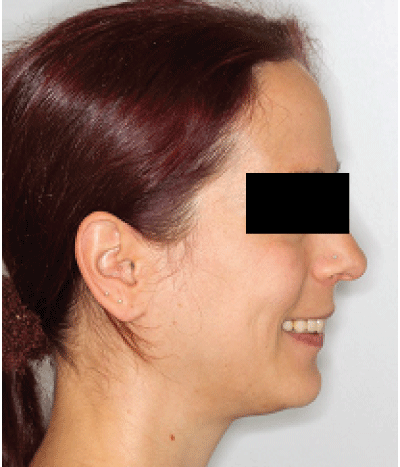
Figure 15: Optimized profile.
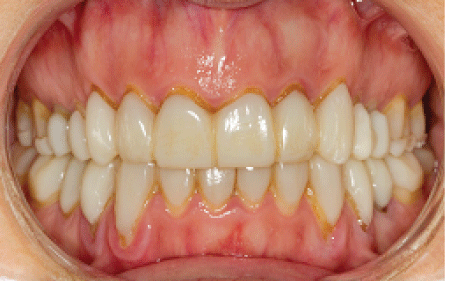
Figure 16: Restoration with single crowns.
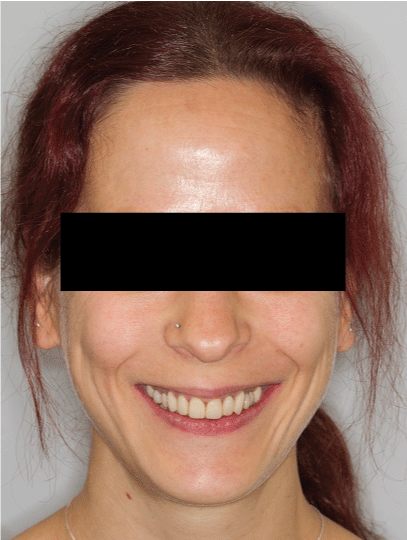
Figure 17: Facial derived harmonic restoration.
A nutritional and psychological assessment was determined to compare the status quo prior and after the dental intervention. For the nutritional evaluation, a 24-hour recall was used. This valid method was applied in combination with a nutritional food program (EBISpro, Germany) to calculate the macro- and micronutrients intake. In addition, a questionnaire according to socio-economic status and lifestyle has been evaluated.
After a settling phase of three months, the acceptance of the physical change by the detachable “sample bite” was assessed. A single dental impression is needed to get the result. The duration from the first impression to finish the complete restorative process took in total seven months.
The novel therapeutic approach and development of a digital workflow: predictability in aesthetics and function through advanced diagnostics and use of rails, step-by-step approach to the aesthetic and functional change by means of a detachable “test bite”, and possible reversibility of restoration by application of a non-prep procedure increase the success forecast for the patient and the dentist.
The CAD/CAM manufactured single tooth crowns had a milling time of about 30 minutes per place. Therefore, the complete restoration took 14.5 hours. With the cutback technique, the upper anterior crowns were individualized. The adhesive attachment of all single tooth crowns on the un-prepared teeth was performed in only one session.
A harmonious length-to-width ratio of the front teeth of the upper jaw was achieved. The stable lip support, the harmonization of the smile line as well as occlusion contacts has been optimized. The smile arc analysis showed a harmonic facial incisal edges of the anterior restorations to the lower lip. A reduction of the gummy smile by the restoration of the adequate red-white relation was observed (Figures 15-17).
After the restoration, the skeletal parameters were recorded again and were compared with the initial values by means of a second teleradiograph analysis. With the enhancement of verticalization we indicated the following changes before and after dental intervention; before: obtused subnasal angle squared through the upper lip, narrow lip vermilion and prominent chin vs. after: sharp subnasal angle, upper lip support, increased vermilion, prominent chin by the accentuation of skeletal Angle-Class II. With the visualized treatment objective (=VTO) the changes were already predictable and were finally confirmed. Lateral teleradiograph analysis after verticalization indicated a change of 3.0° for the lower height of the face (before: 44.2° vs. after: 47.2°). The intermaxillary relation increased with 1.8° (before: 4.8° vs. after: 6.6°) and skeletal Angle-Class II was accentuated. Natural tooth anatomy and tooth colour was achieved (Figure 16). In addition, further dental conditions have been changed into aesthetic smile, no discomfort, improved articulation and better formation of sounds. After the treatment chewing difficulties, toothache and tooth sensitivity (hot, cold, sour, and sweet) disappeared. Moreover, the patient’s perception of her teeth has changed.
The 2.5 years psychotherapy, dental intervention and the willingness of the patient to change her life had a drastic impact on lifestyle, nutritional and psychological aspects. The changes according to the patient’s lifestyle were associated with changes concerning oral factors like vomiting, smoking and eating consumption. Prior to the dental intervention, the patient vomiting episodes were before four up to 10 times per day. The patient stopped eating frequently uncontrollable amounts of high-calorie food. The episodes of excessive uncontrolled eating alternate with rigorous fasting and self-induced vomiting were discontinued, resulted in cost saving of approximately 50% per month (before: ~500 €/month vs. after: ~250 €/month). Eating behavior changed from huge food amounts into better quality, small portions into a more conscious eating. Concerning social life and eating behavior, the patient has changed (before: eating alone/self-isolation vs. after: eating with friends up to 3x/week). In addition, changes in smoking behavior (before: 15 cigarettes/d vs. after: non-smoker), physical activity (before: no/irregular sport vs. after: running or gymnastics 2h/week) and physical perception (before: no awareness of the body vs. after: own body consciousness development) was noticed. The patient has gained two kilograms and the body mass index (BMI) has increased from underweight to the category normal weight (before: 18.4 kg/m² vs. after: 19.1 kg/m²). The following tables summarize the lifestyle, nutritional and psychological associated changes (Table 1).
| Before Treatment | After Treatment |
| Underweight and BMI too low (50 kg, BMI: 18.4 kg/m2) | Normal weight and BMI optimization (52 kg, BMI: 19.1 kg/m2) |
| Vomiting (4-10x/d) | No self-induced vomiting |
| Excessive food consumption (>7.000 kcal/d) | Recommended food intake (~1.600 kcal/d) |
| Smoker (~15 cigarettes/d) | Non-smoker |
| No alcohol | Enjoy to drink alcohol (2 glasses wine/1-2x week) |
| Ashamed to smile | Patient likes her own smile |
| Singing: no appropriate sound production | Improved singing and articulation |
| Discomfort or pain while chewing, hypersensitivity of teeth | No discomfort, no pain while chewing, no hypersensitivity of teeth |
| No physical activity | 2h/week running or gymnastics |
| No food consumption in company | Eating in company 3x/week |
| No care for friendships, self- isolation | Care for friends, friendships |
| No awareness of her own body | Development of body awareness |
Table 1: Lifestyle, nutritional and psychological changes after the dental treatment.
Before dental intervention, the macronutrient intake was extremely increased in comparison to the recommended intakes. After the treatment, the macronutrient intake was according to the recommend daily intake. Prior to the intervention, the carbohydrates intake was twice compared to the recommendations (before: of 526 g/d vs. after: 176 g/d) and energy intake was four times higher (before: 7077 kcal/d vs. after: 1568 kcal/d). Protein consumption was six times increased (before: 305 g/d vs. after: 62 g/d), and fat consumption was even eight times increased compared to current recommendations (before: 411 g/d vs. after: 59 g/d).
The following figure represents actual energy intake before and after the dental intervention in comparison to recommended energy intake for this individual patient (Figure 18).
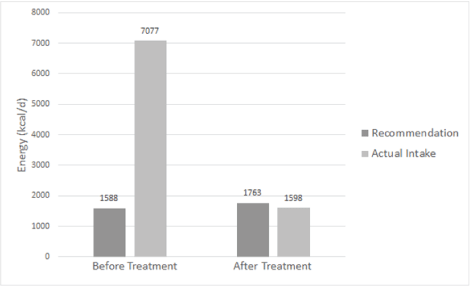
Figure 18: Energy intake: recommendations versus actual intake before and after dental treatment.
The patient had the eating disorder bulimia nervosa since she was 12 years old. In most patients with bulimia nervosa, erosions in varying degrees of severity and lasting consequential damages in function and aesthetics can be detected, which was also found in this patient. This eating disorder led to impairment of masticatory function, impaired articulation, and formation of sounds, muscular dysfunction and compression of mandibular joint.
With the novel restorative digital workflow, a complex case leads to diagnostics, to prediction and results in rehabilitation. The aim is to rely on an innovative standardized approach of a restorative therapy for predictability in complex patient cases: the prediction for each individual complex bulimia nervosa patient will be determined by a combination of virtually-and facially-derived and clinical methods.
In this present case of diagnosed tooth wear, the application of the digital workflow with the four step technique and the use of the virtual articulator supported a transfer from a complex prosthodontic case into a simple one [2,28,29]. The definitive rehabilitation with single ceramic crowns can be realized step-bystep as a simple case because of the already determined vertical dimension and bite position. The biomimetics was successive achieved by an additive process [30,31].
The patient was already psychologically stressed and therefore dental therapy should be as little invasive as possible and less time consuming. The new therapeutic approach involving the digital workflow offers as advantages the predictability in aesthetics and function by an advanced digitally supported diagnosis and the use of CAD/CAM-manufactured splints. A ‘gradual’ non-invasive introduction to the aesthetic and functional changes by CAD/CAMmanufactured removable ‘sample dentures’. The possible reversibility of the restoration by applying a non-prep method (i.e. bonding of CAD/CAM-manufactured single crowns on unprepared teeth). The transformation of a complex case into a simple case for the definitive restoration was conducted with the digital supported four step technique. The corrections were made according to the dynamics. The placement in the maxilla and the mandible must be repeatedly corrected, since it is not possible to take both jaws into account for the use of the dynamic occlusion in the virtual articulator. Hence, the displacement must be adjusted by physical means. Each tooth must be freely shaped and the contact point must be adjusted, which is a timeconsuming procedure. A virtual remodeling of the occlusal surfaces was essential.
The material choice for this patient was CAD/CAM-milled monolithic single crowns made out of VITA ENAMIC® (Vita, Zahnfabrik), a hybrid dental ceramic with a dual network structureceramic and acrylate polymer. This material has no chemical solubility according to ISO 6872, edge-stable to 0.2 mm; it can be corrected with composites in the mouth, and has a very good bond with adhesive attachment due to etch ability [32].
Early recognition and targeted therapeutic measures can support and avoid irreversible damage to the tooth structure at the masticatory system, or if they already exist, to prevent further progression. A novel concept is the dental psycho education. This innovative therapy connects for the first time the interaction of dental interventions with psycho education. The dentist is an integral component in the training of people who suffer from a mental disorder. This method examined the impact of detachable sample denture treatment on teeth in a bulimia nervosa patient. The dental restorative treatment was well tolerated without any complications.
The macronutrient intake was twice up to eight times higher compared to the recommendations. Moreover, an under-reporting bias of 10-20% has to be taken into account. Therefore, the real daily nutrient intake was much higher. At the final visit, the patient had a slightly decreased energy intake, which has been in the meantime adapted to the recommended daily intakes.
Through the prosthetic rehabilitation and restoration of the patient’s smile, there have been numerous improvements. Previously, the mouth was the scene of the patient’s disease; now it has changed to a pleasure zone.
We present a unique digital workflow focusing on the dental effectiveness of a minimal invasive technique in patients with bulimia nervosa. This was the first study on dental restorative techniques applied in a bulimia nervosa patient.
The benefits are that this technique is an approach, which is innovative, fully digital, less invasive, faster and cost-effective.
However, we are working on accepting that this concept will be supported by the Austrian health insurance. A stronger networking of all professional groups working with bulimia patients is needed to improve the quality of patient care, to shorten the period of treatment and to reduce costs in the long term.
In summary, a dental restorative digital workflow can help to preserve dental health and to strengthen the compliance of psychotherapeutic treatment. Cooperation between psychosocial and dental care from the beginning is useful and desirable.
In the present trial, we investigated the impact of dental restorative treatment for patients with bulimia nervosa. The new therapeutic approach involving the digital workflow provides the digital support in the complex prosthetic rehabilitation using the simulation of the expected result via several intermediate steps to increase the success prognosis for both patient and dentist. The treatment was well tolerated and resulted in lifestyle, nutritional and psychological benefits.
We thank the native speaker and dentist Dr. Gary Price. BDS, MFDS.RCS (Eng.) for proof reading the manuscript.
Download Provisional PDF Here
Article Type: RESEARCH ARTICLE
Citation: Kotlarenko P, Vaskovich T, Skolka A, Moritz A, Kreissl A (2018) Development of a Novel Restorative Digital Workflow for Patients with Bulimia Nervosa, Report of a Case. Int J Dent Oral Health 4(5): dx.doi.org/10.16966/2378-7090.274
Copyright: © 2018 Kotlarenko P, et al. This is an open-access article distributed under the terms of the Creative Commons Attribution License, which permits unrestricted use, distribution, and reproduction in any medium, provided the original author and source are credited.
Publication history:
All Sci Forschen Journals are Open Access